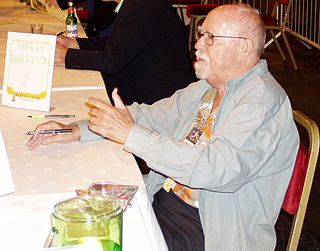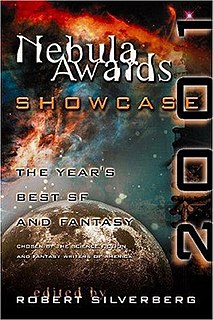Related Research Articles

Brian Wilson Aldiss was an English writer, artist, and anthology editor, best known for science fiction novels and short stories. His byline reads either Brian W. Aldiss or simply Brian Aldiss, except for occasional pseudonyms during the mid-1960s.

John Wood Campbell Jr. was an American science fiction writer and editor. He was editor of Astounding Science Fiction from late 1937 until his death and was part of the Golden Age of Science Fiction. Campbell wrote super-science space opera under his own name and stories under his primary pseudonym, Don A. Stuart. Campbell also used the pen names Karl Van Kampen and Arthur McCann. His novella Who Goes There? was adapted as the films The Thing from Another World (1951), The Thing (1982), and The Thing (2011).

The scientific method is an empirical method of acquiring knowledge that has characterized the development of science since at least the 17th century. It involves careful observation, applying rigorous skepticism about what is observed, given that cognitive assumptions can distort how one interprets the observation. It involves formulating hypotheses, via induction, based on such observations; experimental and measurement-based testing of deductions drawn from the hypotheses; and refinement of the hypotheses based on the experimental findings. These are principles of the scientific method, as distinguished from a definitive series of steps applicable to all scientific enterprises.
The New Wave was a science fiction (SF) movement in the 1960s and 1970s characterized by a high degree of experimentation in form and content, a "literary" or artistic sensibility, and a focus on "soft" as opposed to hard science. New Wave writers often saw themselves as part of the modernist tradition in fiction, and the New Wave was conceived as a deliberate break from the traditions of pulp science fiction, which many of the writers involved considered irrelevant and unambitious. They thus emphasized stylistic experimentation and literary merit over the scientific accuracy or prediction of hard science fiction writers.
"Faith of Our Fathers" is a science fiction short story by American writer Philip K. Dick, first published in the anthology Dangerous Visions (1967).

Harry Max Harrison was an American science fiction author, known mostly for his character The Stainless Steel Rat and for his novel Make Room! Make Room! (1966). The latter was the rough basis for the motion picture Soylent Green (1973). Long resident in both Ireland and the United Kingdom, Harrison was involved in the foundation of the Irish Science Fiction Association, and was, with Brian Aldiss, co-president of the Birmingham Science Fiction Group.

The Demon-Haunted World: Science as a Candle in the Dark is a 1995 book by the astrophysicist Carl Sagan and co-authored by Ann Druyan, in which the authors aim to explain the scientific method to laypeople and to encourage people to learn critical and skeptical thinking. They explain methods to help distinguish between ideas that are considered valid science and those that can be considered pseudoscience. Sagan states that when new ideas are offered for consideration, they should be tested by means of skeptical thinking and should stand up to rigorous questioning.

New Worlds was a British science fiction magazine that began in 1936 as a fanzine called Novae Terrae. John Carnell, who became Novae Terrae's editor in 1939, renamed it New Worlds that year. He was instrumental in turning it into a professional publication in 1946 and was the first editor of the new incarnation. It became the leading UK science fiction magazine; the period to 1960 has been described by science fiction historian Mike Ashley as the magazine's "Golden Age".
Prometheus Books is a publishing company founded in August 1969 by the philosopher Paul Kurtz. The publisher's name was derived from Prometheus, the Titan from Greek mythology who stole fire from Zeus and gave it to man. This act is often used as a metaphor for bringing knowledge or enlightenment.

Two Tales and Eight Tomorrows is a collection of science fiction stories by American writer Harry Harrison between 1958 and 1965. It was published in 1965 by Victor Gollancz Ltd.

New Writings in SF 22 is an anthology of science fiction short stories edited by Kenneth Bulmer, the first volume of nine he oversaw in the New Writings in SF series in succession to the series' originator, John Carnell. It was first published in hardcover by Sidgwick & Jackson in 1973, followed by a paperback edition under the slightly variant title New Writings in SF - 22 issued by Corgi in 1974. The contents of this volume, together with those of volumes 21 and 23 of the series, were later included in the omnibus anthology New Writings in SF Special 1, issued by Sidgwick & Jackson in 1975.

The Golden Age of Science Fiction is an anthology of science fiction short stories all originally published between 1949 and 1962. The stories were selected and introduced by Kingsley Amis, who also wrote an Editor's Note and a 21-page Introduction. The collection was first published by Hutchinson in 1981 and was released in paperback by Penguin in 1983.
"Gene Hive" is a science fiction short story by English author Brian Aldiss. It was first published, as "Journey to the Interior", in 1958 in Nebula Science Fiction #30 and first collected, as "Gene-Hive", in The Canopy of Time

Best SF: 1968 is the second on a series of annual anthologies of science fiction stories edited by Harry Harrison and Brian W. Aldiss, first published in a British edition in January 1969 by Sphere Books. The first American edition was released later that year by Putnam, with a Berkley paperback following shortly thereafter. Severn House issued a British hardcover edition in 1977.

Nova 1 is the first in a series of anthologies of original science fiction stories edited by American writer Harry Harrison, published by Delacorte Press in 1970. A Science Fiction Book Club edition was issued later that year, with a Dell paperback reprint following in 1971. A British paperback appeared in 1975, with an abridged British hardcover following in 1976. Nova 1 placed 15th in the 1971 Locus Poll in the Anthologies/Collections category.

Souls in Metal: an Anthology of Robot Futures is an anthology of robot-themed science fiction short stories edited by Mike Ashley. It was first published in hardcover by Robert Hale in February 1977 in the United Kingdom, with an American hardcover edition following from St. Martin's Press in June of the same year, and a paperback edition from Jove/HBJ in June 1978.

Nebula Awards Showcase 2001 is an anthology of science fiction short works edited by Robert Silverberg. It was first published in hardcover and trade paperback by Harcourt in April 2001.

Nebula Award Stories Two is an anthology of science fiction short stories edited by Brian W. Aldiss and Harry Harrison. It was first published in hardcover by Doubleday in September 1967, with a Science Fiction Book Club edition following in November 1969. The first British edition was published by Gollancz in 1967, under the variant title Nebula Award Stories 1967. Paperback editions followed from Pocket Books in the U.S. in September 1968, and Panther in the U.K. in 1970. The Panther edition bore the variant title Nebula Award Stories 2. The book was more recently reissued by Stealth Press in hardcover in September 2001. It has also been published in German.

Nebula Award Stories 1965 is an anthology of science fiction short works edited by Damon Knight. It was first published in hardcover by Doubleday in 1966, with a Science Fiction Book Club edition following in October of the same year. The first British edition was published by Gollancz in 1967. Paperback editions followed from Pocket Books in the U.S. in November 1967, and New English Library in the U.K. in April 1969. The U.K. and paperback editions bore the variant title Nebula Award Stories 1. The book was more recently reissued by Stealth Press in hardcover in February 2001. It has also been published in German.

Universe 3 is an anthology of original science fiction short stories edited by Robert Silverberg and Karen Haber, the third and last volume in a series of three, continuing an earlier series of the same name edited by Terry Carr. It was first published in paperback by Bantam Books in April 1994.
References
- ↑ Aldiss, Brian (ed.)(1972): The Penguin Science Fiction Omnibus. Harmondsworth, UK: Penguin Books, p. 321
- ↑ The Streets of Ashkelon at HarryHarrison.com; retrieved August 8, 2007
- ↑ Review of Harrison's 2001 anthology, 50 in 50 at SciFi.com (via archive.org)
- ↑ Fourth Lecture, from Paul Cook's official site at Arizona State University